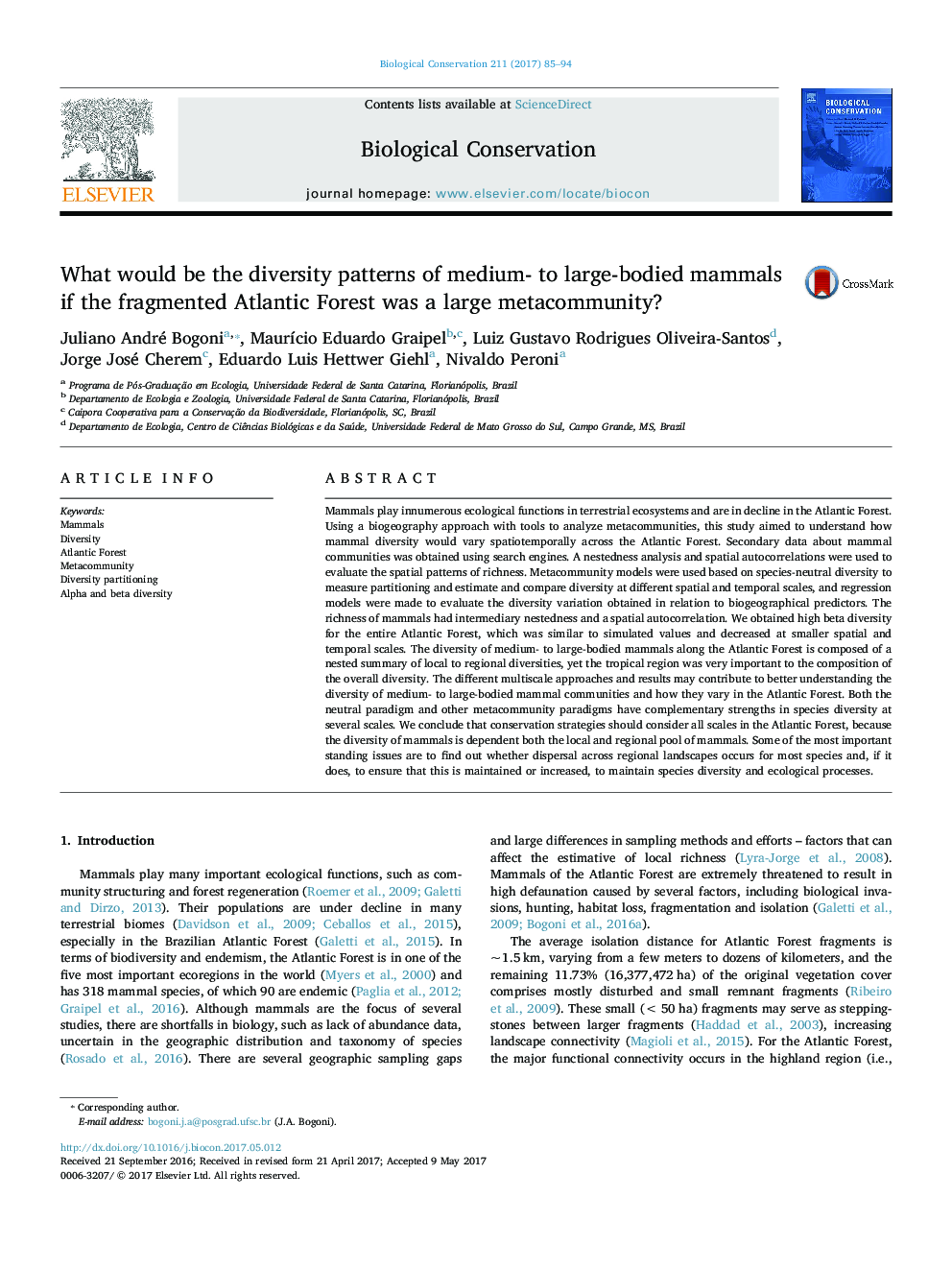| کد مقاله | کد نشریه | سال انتشار | مقاله انگلیسی | نسخه تمام متن |
|---|---|---|---|---|
| 5743141 | 1412297 | 2017 | 10 صفحه PDF | دانلود رایگان |
عنوان انگلیسی مقاله ISI
What would be the diversity patterns of medium- to large-bodied mammals if the fragmented Atlantic Forest was a large metacommunity?
ترجمه فارسی عنوان
اگر الگوی جنگل اقیانوس اطلس متشکل از یک جامعه بزرگ بود چه الگوهای متنوعی از پستانداران متوسط و بزرگ وجود خواهد داشت؟
دانلود مقاله + سفارش ترجمه
دانلود مقاله ISI انگلیسی
رایگان برای ایرانیان
کلمات کلیدی
موضوعات مرتبط
علوم زیستی و بیوفناوری
علوم کشاورزی و بیولوژیک
بوم شناسی، تکامل، رفتار و سامانه شناسی
چکیده انگلیسی
Mammals play innumerous ecological functions in terrestrial ecosystems and are in decline in the Atlantic Forest. Using a biogeography approach with tools to analyze metacommunities, this study aimed to understand how mammal diversity would vary spatiotemporally across the Atlantic Forest. Secondary data about mammal communities was obtained using search engines. A nestedness analysis and spatial autocorrelations were used to evaluate the spatial patterns of richness. Metacommunity models were used based on species-neutral diversity to measure partitioning and estimate and compare diversity at different spatial and temporal scales, and regression models were made to evaluate the diversity variation obtained in relation to biogeographical predictors. The richness of mammals had intermediary nestedness and a spatial autocorrelation. We obtained high beta diversity for the entire Atlantic Forest, which was similar to simulated values and decreased at smaller spatial and temporal scales. The diversity of medium- to large-bodied mammals along the Atlantic Forest is composed of a nested summary of local to regional diversities, yet the tropical region was very important to the composition of the overall diversity. The different multiscale approaches and results may contribute to better understanding the diversity of medium- to large-bodied mammal communities and how they vary in the Atlantic Forest. Both the neutral paradigm and other metacommunity paradigms have complementary strengths in species diversity at several scales. We conclude that conservation strategies should consider all scales in the Atlantic Forest, because the diversity of mammals is dependent both the local and regional pool of mammals. Some of the most important standing issues are to find out whether dispersal across regional landscapes occurs for most species and, if it does, to ensure that this is maintained or increased, to maintain species diversity and ecological processes.
ناشر
Database: Elsevier - ScienceDirect (ساینس دایرکت)
Journal: Biological Conservation - Volume 211, Part A, July 2017, Pages 85-94
Journal: Biological Conservation - Volume 211, Part A, July 2017, Pages 85-94
نویسندگان
Juliano André Bogoni, MaurÃcio Eduardo Graipel, Luiz Gustavo Rodrigues Oliveira-Santos, Jorge José Cherem, Eduardo Luis Hettwer Giehl, Nivaldo Peroni,
